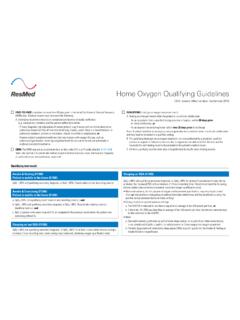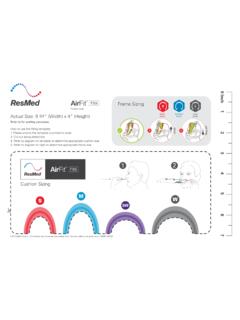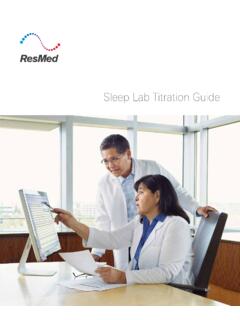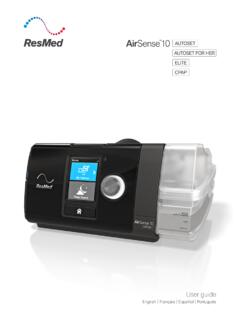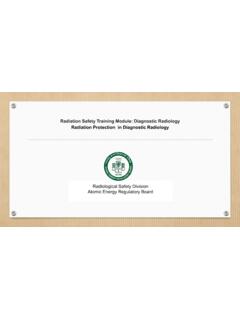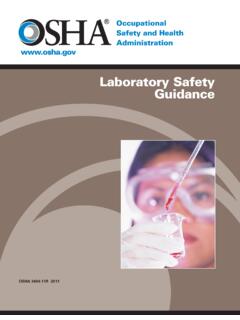Transcription of English Français Español Português - ResMed
1 English Fran ais Espa ol Portugu sUser guideDevice settingFull faceUSER GUIDEE nglish 1 English Thank you for choosing the AirFit F30i full face mask. This mask uses a cushion that seals under the nose and around the mouth, and a frame with a tube connection above the head. To breathe fresh air, this mask features vent holes in the cushion and elbow, and valves in the frame. A Elbow 4 Elbow ring B Frame 5 Anti-Asphyxia valve (inside the left and right of frame connector) C Cushion D Headgear 6 Frame connector 1 Vent holes (cushion) 7 Magnetic clip 2 Vent holes (elbow) 8 Lower headgear strap 3 Side button 9 Upper headgear strap Intended Use The AirFit F30i mask is intended to be used by patients weighing more than 66 lb (30 kg) who have been prescribed non-invasive positive airway pressure (PAP) therapy such as CPAP or bi-level therapy. The mask is intended for single patient re-use in the home and multi-patient re-use in the hospital/institutional environment.
2 2 Contraindications Use of masks with magnetic components is contraindicated in patients with the following pre-existing conditions: a metallic hemostatic clip implanted in your head to repair an aneurysm metallic splinters in one or both eyes. Before using your mask Remove all packaging and inspect each mask component for visible deterioration. Fitting your mask English 3 1. Connect the air tubing from your device to the elbow. 2. Squeeze the side buttons on the elbow and pull from the frame. Put the elbow and air tubing aside for now. 3. Twist and pull both magnetic clips away from the frame connectors. 4. Place the cushion under your nose and ensure it sits comfortably against your face. With the ResMed logo on the headgear facing up, pull the headgear and frame over your head. 5. Bring the lower headgear straps under your ears and attach the magnetic clips to the frame connectors. 6. Undo the fastening tabs on the upper headgear straps and pull evenly.
3 Repeat with the lower headgear straps. 7. Attach the elbow to the top of the frame. Your mask should now be positioned as shown. Adjusting your mask With the device turned on and blowing air, adjust the position of the cushion for the most comfortable seal under your nose. Ensure that the cushion is not creased and the headgear is not twisted. To fix any mask leaks, adjust the upper or lower headgear straps. Adjust only enough for a comfortable seal and do not overtighten. Sizing the mask Use the fitting template to assist in selecting the right size cushion. If the mask frame falls back over your head or sits too close to your ears, try a smaller frame size. If the mask falls forward on your head or sits too close to your eyes, try a bigger frame size. 4 Disassembling your mask for cleaning If your mask is connected to a device, disconnect the device air tubing from the mask elbow. 1. Undo the fastening tabs on the upper headgear straps and pull from the frame.
4 Keep the magnetic clips attached to the lower headgear straps. 2. Squeeze the side buttons on the elbow and detach from the frame. 3. Grip the frame connector and lift to unclip from the cushion. Repeat on the other side. Cleaning your mask If there is any visible deterioration of a mask component (cracking, crazing, tears etc.) the component should be discarded and replaced. Daily/After each use: Cushion Weekly: Headgear, frame and elbow 1. Soak the components in warm water with a mild liquid detergent. 2. Hand wash the components with a soft bristle brush. Pay particular attention to the vent holes in both cushion and elbow. 3. Thoroughly rinse the components under running water. 4. Leave the components to air dry out of direct sunlight. If the mask components are not visibly clean, repeat the cleaning steps. Make sure that the vent holes and anti-asphyxia valves are clean and clear. English 5 Reassembling your mask 1. Align and insert the frame connector tab (a) into the cushion slot (b) and press down until it clicks.
5 Repeat on the other side. 2. Attach the elbow to the top of the frame until it clicks. 3. With the ResMed logo facing outwards and up, insert the upper headgear straps into the frame from the inside and fold the fastening tabs over to secure. Note: If the elbow ring detaches, re-insert into the top of the frame. WARNING Magnets are used in the lower headgear straps and the frame of the mask. Ensure the headgear and frame is kept at least 2" (50 mm) away from any active medical implant (eg, pacemaker or defibrillator) to avoid possible effects from localized magnetic fields. The magnetic field strength is less than 400 mT. The mask contains safety features, the exhaust vent holes and anti-asphyxia valves, to enable normal breathing and exhaust exhaled breath. Occlusion of the exhaust vent holes or anti-asphyxia valves needs to be prevented to avoid having an adverse effect on the safety and quality of the therapy. Regularly inspect the vent holes and anti-asphyxia valves to ensure they are kept clean, clear of blockages and are not damaged.
6 Only use compatible CPAP or bi-level therapy devices or accessories. The technical specifications of the mask are provided for healthcare professionals to determine compatible devices. Use in combination with incompatible medical devices can decrease the safety or alter the performance of the mask. The mask is not suitable for patients requiring life support ventilation. Regularly clean your mask and its components to maintain the quality of your mask and to prevent the growth of germs that can adversely affect your health. 6 WARNING The mask must be used under qualified supervision for patients who are unable to remove the mask by themselves. The mask may not be suitable for those prone to aspiration. The mask should not be used unless the device is turned on. Once the mask is fitted, ensure the device is blowing air to reduce risk of rebreathing exhaled air. Discontinue using or replace this mask if the patient has ANY adverse reaction to the use of the mask.
7 Consult your physician or sleep therapist. The mask is not intended to be used simultaneously with nebulizer medications that are in the air path of the mask/tube. If there is any visible deterioration of a mask component (cracking, crazing, tears etc.) the component should be discarded and replaced. CAUTION Always follow cleaning instructions and only use a mild liquid detergent. Some cleaning products may damage the mask, its parts and their function, or leave harmful residual vapours. Do not use a dish washer or washing machine to clean the mask. When fitting the mask, do not overtighten the headgear as this may lead to skin redness or sores around the mask cushion. As with all masks, some rebreathing may occur at low pressures. Using a mask may cause tooth, gum or jaw soreness or aggravate an existing dental condition. If symptoms occur, consult your physician or dentist. Do not iron the headgear as the material is heat sensitive and will be damaged.
8 English 7 Technical specifications Mask setting options: For AirSense, AirCurve or S9: Select 'Full Face'. Compatible devices: For a full list of compatible devices for this mask, see the Mask/Device Compatibility List at SmartStop may not operate effectively when using this mask with some CPAP or bi-level devices. Pressure-flow curve Pressure (cm H2O) Flow (L/min) 4 22 11 38 17 48 24 59 30 67 Therapy pressure: 4 to 30 cm H20 Resistance with Anti Asphyxia Valve closed to atmosphere Drop in pressure measured (nominal) at 50 L/min: cm H2O Drop in pressure measured (nominal) at 100 L/min: cm H2O Resistance with Anti Asphyxia Valve open to atmosphere Inspiration at 50 L/min: cm H2O Expiration at 50 L/min: cm H2O Anti-Asphyxia Valve open-to-atmosphere pressure: <4 cm H2O Anti-Asphyxia Valve closed-to-atmosphere pressure: <4 cm H2O Sound: Declared dual-number noise emission values in accordance with ISO4871:1996 and ISO3744:2010.
9 A-weighted sound power level is 25 dBA, with uncertainty of 3 dBA. A-weighted pressure level at a distance of 1 m is 18 dBA, with uncertainly of 3 dBA. Environmental conditions Operating temperature: 41 F to 104 F (5 C to 40 C) Operating humidity: 15% to 95% RH non-condensing Storage and transport temperature: -4 F to 140 F (-20 C to +60 C) Storage and transport humidity: up to 95% RH non-condensing International Commission on Non- ionizing radiation protection (ICNIRP) Magnets used in this mask are within ICNIRP guidelines for general public use. Service life: The service life of the mask system is dependent on the intensity of usage, maintenance, and environmental conditions to which the mask is used or stored. As this mask system and its components are modular in nature, it is recommended that the user maintain and inspect it on a regular basis, and replace the mask system or any 8 components if deemed necessary or according to the instructions in the Cleaning your mask section of this guide.
10 Accessories: Soft sleeves are available as an accessory, Storage Ensure that the mask is thoroughly clean and dry before storing it for any length of time. Store the mask in a dry place out of direct sunlight. Disposal This mask does not contain any hazardous substances and may be disposed of with your normal household refuse. Reprocessing the mask between patients Only Sleep Lab Mask (SLM) variants of the mask system are intended for multi-patient re-use. When using between patients, these masks must be reprocessed according to instructions available on Symbols The following symbols may appear on your product or packaging: Full face mask Device setting- Full face Small frame Standard frame Large frame Cushion size - small Cushion size - medium Cushion size - small wide Cushion size - wide Caution, consult accompanying documents. Prescription only (In the US, Federal law restricts these devices to sale by or on the order of a physician.)
